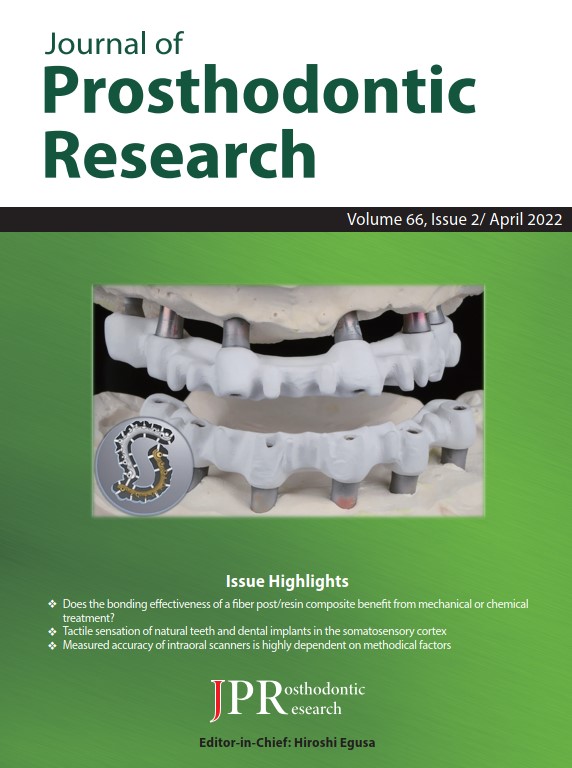Special Edition
66 巻, 2 号
選択された号の論文の22件中1~22を表示しています
- |<
- <
- 1
- >
- >|
Editorial
-
原稿種別: Editorial
2022 年66 巻2 号 p. vi-vii
発行日: 2022年
公開日: 2022/04/27
PDF形式でダウンロード (150K)
Review Articles
-
原稿種別: Review article
2022 年66 巻2 号 p. 193-207
発行日: 2022年
公開日: 2022/04/27
[早期公開] 公開日: 2021/06/25PDF形式でダウンロード (796K) -
原稿種別: Review article
2022 年66 巻2 号 p. 208-220
発行日: 2022年
公開日: 2022/04/27
[早期公開] 公開日: 2021/07/15PDF形式でダウンロード (805K) -
原稿種別: Review article
2022 年66 巻2 号 p. 221-225
発行日: 2022年
公開日: 2022/04/27
[早期公開] 公開日: 2021/09/11PDF形式でダウンロード (292K) -
原稿種別: Review article
2022 年66 巻2 号 p. 226-235
発行日: 2022年
公開日: 2022/04/27
[早期公開] 公開日: 2021/09/16PDF形式でダウンロード (1334K)
Original Articles
-
原稿種別: Original article
2022 年66 巻2 号 p. 236-242
発行日: 2022年
公開日: 2022/04/27
[早期公開] 公開日: 2021/07/21PDF形式でダウンロード (2206K) -
Effects of abutment tooth and luting agent colors on final color of high-translucent zirconia crowns原稿種別: Original article
2022 年66 巻2 号 p. 243-249
発行日: 2022年
公開日: 2022/04/27
[早期公開] 公開日: 2021/07/29PDF形式でダウンロード (674K) -
原稿種別: Original article
2022 年66 巻2 号 p. 250-257
発行日: 2022年
公開日: 2022/04/27
[早期公開] 公開日: 2021/08/31PDF形式でダウンロード (329K) -
原稿種別: Original article
2022 年66 巻2 号 p. 258-264
発行日: 2022年
公開日: 2022/04/27
[早期公開] 公開日: 2021/07/21PDF形式でダウンロード (584K) -
原稿種別: Original article
2022 年66 巻2 号 p. 265-271
発行日: 2022年
公開日: 2022/04/27
[早期公開] 公開日: 2021/08/04PDF形式でダウンロード (911K) -
原稿種別: Original article
2022 年66 巻2 号 p. 272-278
発行日: 2022年
公開日: 2022/04/27
[早期公開] 公開日: 2021/08/04PDF形式でダウンロード (1063K) -
原稿種別: Original article
2022 年66 巻2 号 p. 279-287
発行日: 2022年
公開日: 2022/04/27
[早期公開] 公開日: 2021/09/30PDF形式でダウンロード (530K) -
原稿種別: Original article
2022 年66 巻2 号 p. 288-295
発行日: 2022年
公開日: 2022/04/27
[早期公開] 公開日: 2021/08/04PDF形式でダウンロード (1235K) -
原稿種別: Original article
2022 年66 巻2 号 p. 296-302
発行日: 2022年
公開日: 2022/04/27
[早期公開] 公開日: 2021/08/31PDF形式でダウンロード (498K) -
原稿種別: Original article
2022 年66 巻2 号 p. 303-311
発行日: 2022年
公開日: 2022/04/27
[早期公開] 公開日: 2021/07/01PDF形式でダウンロード (659K) -
原稿種別: Original article
2022 年66 巻2 号 p. 312-317
発行日: 2022年
公開日: 2022/04/27
[早期公開] 公開日: 2021/09/11PDF形式でダウンロード (370K) -
原稿種別: Original article
2022 年66 巻2 号 p. 318-325
発行日: 2022年
公開日: 2022/04/27
[早期公開] 公開日: 2021/08/28PDF形式でダウンロード (762K) -
原稿種別: Original article
2022 年66 巻2 号 p. 326-332
発行日: 2022年
公開日: 2022/04/27
[早期公開] 公開日: 2021/07/21PDF形式でダウンロード (487K) -
原稿種別: Original article
2022 年66 巻2 号 p. 333-338
発行日: 2022年
公開日: 2022/04/27
[早期公開] 公開日: 2021/09/17PDF形式でダウンロード (786K) -
原稿種別: Original article
2022 年66 巻2 号 p. 339-345
発行日: 2022年
公開日: 2022/04/27
[早期公開] 公開日: 2021/09/23PDF形式でダウンロード (357K)
Technical procedure
-
原稿種別: Technical procedure
2022 年66 巻2 号 p. 346-352
発行日: 2022年
公開日: 2022/04/27
[早期公開] 公開日: 2021/09/18PDF形式でダウンロード (534K)
Case report
-
原稿種別: Case report
2022 年66 巻2 号 p. 353-356
発行日: 2022年
公開日: 2022/04/27
[早期公開] 公開日: 2021/07/15PDF形式でダウンロード (395K)
- |<
- <
- 1
- >
- >|
